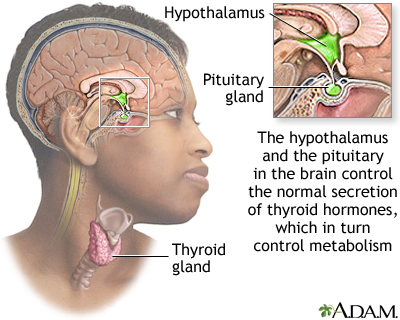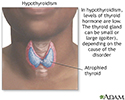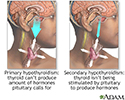Hypothyroidism
Myxedema; Adult hypothyroidism; Underactive thyroid; Goiter - hypothyroidism; Thyroiditis - hypothyroidism; Thyroid hormone - hypothyroidism
Hypothyroidism is a condition in which the thyroid gland does not make enough thyroid hormone. This condition is often called underactive thyroid.
Causes
The thyroid gland is an important organ of the endocrine system . It is located at the front of the neck, just above where your collarbones meet. The thyroid makes hormones that control the way every cell in the body uses energy. This process is called metabolism .
Endocrine system
Endocrine glands release (secrete) hormones into the bloodstream. The endocrine glands include:AdrenalHypothalamusIslets of Langerhans in the pancrea...

Metabolism
Metabolism refers to all the physical and chemical processes in the body that convert or use energy, such as:BreathingCirculating bloodControlling bo...

Hypothyroidism is more common in women and people over age 50.
The most common cause of hypothyroidism is thyroiditis. Swelling and inflammation damage the thyroid gland's cells.
Causes of this problem include:
- The immune system attacking the thyroid gland
- Viral infections (common cold) or other respiratory infections
- Pregnancy (often called postpartum thyroiditis)
Other causes of hypothyroidism include:
- Certain medicines, such as lithium and amiodarone
- Congenital (birth) defects
- Radiation treatments to the neck or brain to treat different cancers
- Radioactive iodine used to treat an overactive thyroid gland
- Surgical removal of part or all of the thyroid gland
-
Sheehan syndrome
, a condition that may occur in a woman who bleeds severely during pregnancy or childbirth and causes the destruction of the pituitary gland
Sheehan syndrome
Sheehan syndrome is a condition that can occur in a woman who bleeds severely during childbirth. Sheehan syndrome is a type of hypopituitarism....
 ImageRead Article Now Book Mark Article
ImageRead Article Now Book Mark Article -
Pituitary tumor
or pituitary surgery
Pituitary tumor
A pituitary tumor is an abnormal growth in the pituitary gland. The pituitary is a small gland at the base of the brain. It regulates the body's ba...
 ImageRead Article Now Book Mark Article
ImageRead Article Now Book Mark Article
Symptoms
Early symptoms:
- Hard stools or constipation
- Increased sensitivity to cold temperature
-
Fatigue or feeling slowed down
Fatigue or feeling slowed down
Fatigue is a feeling of weariness, tiredness, or lack of energy.
Read Article Now Book Mark Article - Heavier and irregular menstrual periods
-
Joint or muscle pain
Joint or muscle pain
Joint pain can affect one or more joints.
 ImageRead Article Now Book Mark Article
ImageRead Article Now Book Mark Article - Paleness or dry skin
- Sadness or depression
-
Thin, brittle hair or fingernails
Thin, brittle hair or fingernails
Nail abnormalities are problems with the color, shape, texture, or thickness of the fingernails or toenails.
 ImageRead Article Now Book Mark Article
ImageRead Article Now Book Mark Article - Weakness
-
Weight gain
Weight gain
Unintentional weight gain is when you gain weight without trying to do so and you are not eating or drinking more.
 ImageRead Article Now Book Mark Article
ImageRead Article Now Book Mark Article
Late symptoms, if untreated:
- Decreased taste and smell
- Hoarseness
- Puffy face, hands, and feet
- Slow speech
- Thickening of the skin
- Thinning of eyebrows
- Low body temperature
- Slow heart rate
Exams and Tests
The health care provider will do a physical exam and may find that your thyroid gland is enlarged. Sometimes, the gland is normal size or smaller-than-normal. The exam may also reveal:
Physical exam
During a physical examination, a health care provider studies your body to determine if you do or do not have a physical problem. A physical examinat...
- Thin brittle hair
- Coarse features of the face
- Pale or dry skin, which may be cool to the touch
- Reflexes that are abnormal
- Swelling of the arms and legs
Blood tests are also ordered to measure your thyroid hormones TSH and T4 .
TSH
A TSH test measures the amount of thyroid stimulating hormone (TSH) in your blood. TSH is produced by the pituitary gland. It tells the thyroid gla...

T4
T4 (thyroxine) is the main hormone produced by the thyroid gland. A laboratory test can be done to measure the amount of free T4 in your blood....

You may also have tests to check:
- Cholesterol levels
-
Complete blood count (
CBC
)
CBC
A complete blood count (CBC) test measures the following:The number of red blood cells (RBC count)The number of white blood cells (WBC count)The tota...
 ImageRead Article Now Book Mark Article
ImageRead Article Now Book Mark Article -
Liver enzymes
Liver enzymes
Liver function tests are common tests that are used to see how well the liver is working. Tests include:AlbuminAlpha-1 antitrypsin Alkaline phosph...
 ImageRead Article Now Book Mark Article
ImageRead Article Now Book Mark Article -
Prolactin
Prolactin
Prolactin is a hormone released by the pituitary gland. The prolactin test measures the amount of prolactin in the blood.
Read Article Now Book Mark Article -
Sodium
Sodium
The sodium blood test measures the amount of sodium in the blood. Sodium can also be measured using a urine test.
 ImageRead Article Now Book Mark Article
ImageRead Article Now Book Mark Article -
Cortisol
Cortisol
The cortisol blood test measures the level of cortisol in the blood. Cortisol is a steroid (glucocorticoid) hormone produced by the adrenal gland. C...
Read Article Now Book Mark Article
Treatment
Treatment is aimed at replacing the thyroid hormone you are lacking.
Levothyroxine is the most commonly used medicine:
- You will be prescribed the lowest dose possible that relieves your symptoms and brings your blood hormone levels back to normal.
- If you have heart disease or you are older, your doctor may start you on a very small dose.
- Most people with an underactive thyroid will need to take this medicine for life.
When starting you on your medicine, your doctor may check your hormone levels every 2 to 3 months. After that, your thyroid hormone levels should be monitored at least once every year.
When you are taking thyroid medicine, be aware of the following:
- DO NOT stop taking the medicine even when you feel better. Continue taking it exactly as your doctor prescribed.
- If you change brands of thyroid medicine, let your doctor know. Your levels may need to be checked.
- What you eat can change the way your body absorbs thyroid medicine. Talk with your doctor if you are eating a lot of soy products or are on a high-fiber diet.
- Thyroid medicine works best on an empty stomach and when taken 1 hour before any other medicines. Ask your doctor if you should take your medicine at bedtime. Taking it at bedtime may allow your body to absorb the medicine better than taking it in the daytime.
- Wait at least 4 hours after taking thyroid hormone before you take fiber supplements, calcium, iron, multivitamins, aluminum hydroxide antacids, colestipol, or medicines that bind bile acids.
While you are taking thyroid replacement therapy, tell your doctor if you have any symptoms that suggest your dose is too high, such as:
-
Palpitations
Palpitations
Palpitations are feelings or sensations that your heart is pounding or racing. They can be felt in your chest, throat, or neck. You may:Have an unpl...
 ImageRead Article Now Book Mark Article
ImageRead Article Now Book Mark Article - Rapid weight loss
- Restlessness or shakiness
- Sweating
Outlook (Prognosis)
In most cases, thyroid hormone level becomes normal with proper treatment. You will likely take a thyroid hormone medicine for the rest of your life.
Possible Complications
Myxedema coma, the most severe form of hypothyroidism, is rare. It occurs when thyroid hormone levels get very low. It can be caused by an infection, illness, exposure to cold, or certain medicines in people with untreated hypothyroidism.
Myxedema coma is a medical emergency that must be treated in the hospital. Some people may need oxygen, breathing assistance (ventilator), fluid replacement, and intensive-care nursing.
Symptoms and signs of myxedema coma include:
- Below normal temperature
- Decreased breathing
-
Low blood pressure
Low blood pressure
Low blood pressure occurs when blood pressure is much lower than normal. This means the heart, brain, and other parts of the body do not get enough ...
Read Article Now Book Mark Article -
Low blood sugar
Low blood sugar
Low blood sugar is a condition that occurs when the body's blood sugar (glucose) decreases and is too low. Blood sugar below 70 mg/dL (3. 9 mmol/L) i...
 ImageRead Article Now Book Mark Article
ImageRead Article Now Book Mark Article - Unresponsiveness
- Inappropriate or uncharacteristic moods
People with untreated hypothyroidism are at increased risk of:
- Infection
- Infertility, miscarriage, giving birth to a baby with birth defects
- Heart disease because of higher levels of LDL (bad) cholesterol
- Heart failure
When to Contact a Medical Professional
Call your provider if you have symptoms of hypothyroidism.
If you are being treated for hypothyroidism, call your doctor if:
-
You develop
chest pain
or rapid heartbeat
Chest pain
Chest pain is discomfort or pain that you feel anywhere along the front of your body between your neck and upper abdomen.
 ImageRead Article Now Book Mark Article
ImageRead Article Now Book Mark Article - You have an infection
- Your symptoms get worse or do not improve with treatment
- You develop new symptoms
References
Brent GA, Weetman AP. Hypothyroidism and thyroiditis. In: Melmed S, Polonsky KS, Larsen PR, Kronenberg HM, eds. Williams Textbook of Endocrinology . Philadelphia, PA: Elsevier; 2016:chap 13
Ferri FF. Hypothyroidism. In: Ferri FF, ed. Ferri's Clinical Advisor 2017 . Philadelphia, PA: Elsevier; 2015:662.
Garber JR, Cobin RH, Gharib H, et al. Clinical practice guidelines for hypothyroidism in adults: cosponsored by the American Association of Clinical Endocrinologists and the American Thyroid Association. Endocr Pract . 2012;18(6):988-1028. PMID: 23246686 www.ncbi.nlm.nih.gov/pubmed/23246686 .
-
Endocrine glands - illustration
Endocrine glands release hormones (chemical messengers) into the bloodstream to be transported to various organs and tissues throughout the body. For instance, the pancreas secretes insulin, which allows the body to regulate levels of sugar in the blood. The thyroid gets instructions from the pituitary to secrete hormones which determine the pace of chemical activity in the body (the more hormone in the bloodstream, the faster the chemical activity; the less hormone, the slower the activity).
Endocrine glands
illustration
-
Hypothyroidism - illustration
Hypothyroidism is a decreased activity of the thyroid gland which may affect all body functions. The rate of metabolism slows causing mental and physical sluggishness. The most severe form of hypothyroidism is myxedema, which is a medical emergency.
Hypothyroidism
illustration
-
Brain-thyroid link - illustration
Although the thyroid gland releases the hormones which govern growth and metabolism, the brain (the pituitary and the hypothalamus) manages the release and the balance of the amount of hormones circulated.
Brain-thyroid link
illustration
-
Primary and secondary hypothyroidism - illustration
Hypothyroidism is a decreased activity of the thyroid gland which may affect all body functions. The rate of metabolism slows causing mental and physical sluggishness. The most severe form of hypothyroidism is myxedema, a medical emergency. Hypothyroidism can be caused by a problem with the thyroid itself (primary), or by the malfunction of the pituitary gland or hypothalamus (secondary).
Primary and secondary hypothyroidism
illustration
-
Endocrine glands - illustration
Endocrine glands release hormones (chemical messengers) into the bloodstream to be transported to various organs and tissues throughout the body. For instance, the pancreas secretes insulin, which allows the body to regulate levels of sugar in the blood. The thyroid gets instructions from the pituitary to secrete hormones which determine the pace of chemical activity in the body (the more hormone in the bloodstream, the faster the chemical activity; the less hormone, the slower the activity).
Endocrine glands
illustration
-
Hypothyroidism - illustration
Hypothyroidism is a decreased activity of the thyroid gland which may affect all body functions. The rate of metabolism slows causing mental and physical sluggishness. The most severe form of hypothyroidism is myxedema, which is a medical emergency.
Hypothyroidism
illustration
-
Brain-thyroid link - illustration
Although the thyroid gland releases the hormones which govern growth and metabolism, the brain (the pituitary and the hypothalamus) manages the release and the balance of the amount of hormones circulated.
Brain-thyroid link
illustration
-
Primary and secondary hypothyroidism - illustration
Hypothyroidism is a decreased activity of the thyroid gland which may affect all body functions. The rate of metabolism slows causing mental and physical sluggishness. The most severe form of hypothyroidism is myxedema, a medical emergency. Hypothyroidism can be caused by a problem with the thyroid itself (primary), or by the malfunction of the pituitary gland or hypothalamus (secondary).
Primary and secondary hypothyroidism
illustration
-
Hypothyroidism
(In-Depth)
-
Hypothyroidism
(Alt. Medicine)
Review Date: 4/23/2015
Reviewed By: Brent Wisse, MD, Associate Professor of Medicine, Division of Metabolism, Endocrinology & Nutrition, University of Washington School of Medicine, Seattle, WA. Internal review and update on 07/24/2016 by David Zieve, MD, MHA, Isla Ogilvie, PhD, and the A.D.A.M. Editorial team.






